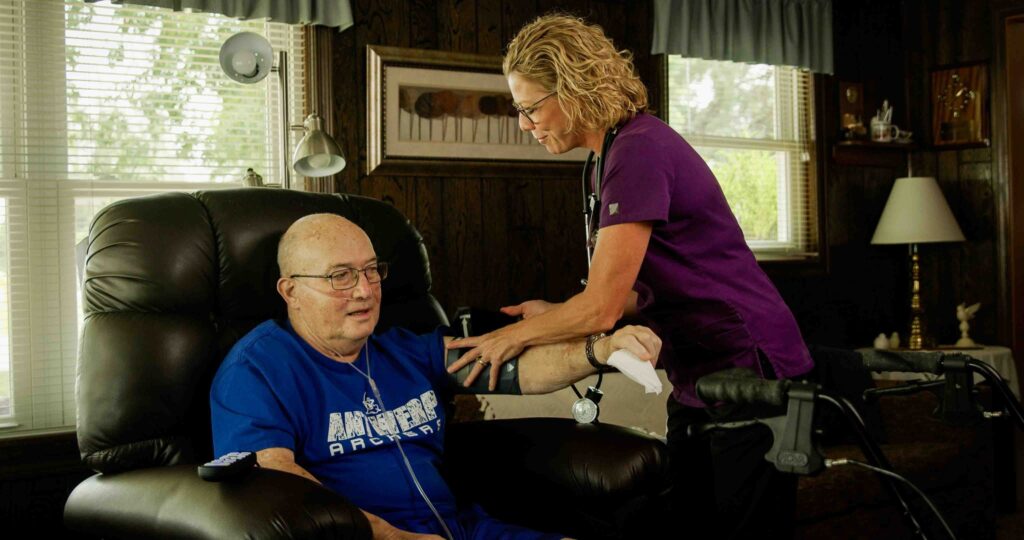By Tom Koutsoumpas | Contributor | US News & World Report | Aug. 18, 2025
No one should face death alone. Nonprofit, community hospice care is the answer.
Before hospice care first came to the United States in the 1970s, the experience of dying in America was often a cold and lonely one. Most people spent their final days in stark, unfamiliar hospital rooms – places that felt more like holding cells than spaces of comfort – often without the warmth, dignity or closeness of those they loved most.
Family visits were brief and confined to strict daytime hours, offering fleeting connection instead of the continuous, human presence that defines hospice care today, which provides end-of-life care that focuses on dignity and comfort.
I’ve witnessed this transformation firsthand. In the 1970s, I was a young staffer for Birch Bayh, then a U.S. senator from Indiana. As I watched the senator’s wife Marvella bravely battle breast cancer and die at the age of 46, I saw how she was forced to endure her final days in a cold, clinical setting devoid of the emotional, spiritual and familial warmth she enjoyed at home. It made a huge impression on me – one that led to a lifetime of advocating for a gentler, dignified way of dying that values people over profits.
Nonprofit hospices face serious challenges
Nonprofit hospices [like CHP Hospice] that are grounded in their communities deliver comprehensive support to patients and families and reinvest every dollar back into mission-driven services. They have consistently delivered some of the highest-quality outcomes for patients and families.
However, nonprofit hospices today face serious challenges – including competition from for-profit entities driven by financial incentives and the potential downstream implications of nearly $1 trillion in cuts to federal funding for Medicaid approved last month. Meanwhile, an ever-more consolidated health care industry will face an enormous burden from a wave of aging baby boomers. We need to be prepared for inevitable growing demand in the coming decades.
The growth of hospice
When I began advocating for improved end-of-life care in the late 1970s and early 1980s, what little care was available in the U.S. was provided through scattered, grassroots efforts. The first fully-fledged hospice in the country opened in Connecticut in 1974; two decades later there were hundreds nationwide.
A significant breakthrough came in the 1980s, when I joined former Florida Rep. Paul Rogers to develop the Medicare Hospice Benefit. Many advocates joined the effort, which resulted in hospice becoming an official benefit in Medicare in 1983, opening the door for millions to get access to better end-of-life care.
Not-for-profit hospice programs rarely turned anyone away. They were among the first to respond to the AIDS crisis, providing dignity for thousands of dying patients left behind by the broader health care system.
Hospice care expanded over the decades, becoming an important component of the nation’s health system. But new providers emerged who were more focused on profit and quantity – and they played a larger and larger role in the industry.
The non-profit difference
Studies, including by the RAND Corporation, show that nonprofit hospices provide more training and more comprehensive and better quality care services than for-profit entities. Yet for-profit enterprises have largely taken over the market. In 2000, nonprofits accounted for roughly 95% of hospice care in the U.S. By 2020, 70% of providers were for-profit, according to data from the Centers for Disease Control and Prevention and MedPAC.
Some for-profit hospices have been associated with lower quality care and family satisfaction, fueling disparities and fragmented care at a time when coordinated, high-quality support is most needed. The fact is that we need more community-based nonprofit hospices.
At a crossroads
But we are at a crossroads now, especially in light of how drastic cuts to health care could unintentionally damage hospice care. We need patients and families to advocate for more, stronger, better care services that center them in decision making. And we need policymakers to develop the laws and regulations needed to support end-of-life care and protect patients.
No one should face their final moments of dying alone, under harsh lights without compassionate care like they did several decades ago.
A strong hospice community is needed today more than ever to guard the very patient-centered values that sparked the hospice movement and to ensure that patients at the end of their lives are surrounded by family, friends and the familiar sounds of home.
###
Tom Koutsoumpas is the founder and CEO of the National Partnership for Healthcare and Hospice Innovation and president of Healthsperien, LLC.

